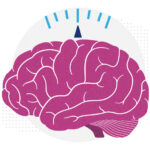Brain wiring predicted adolescents’ emotional health during COVID

The COVID-19 pandemic was emotionally devastating for many adolescents, disrupting their schooling and social/emotional development. Drawing on national data, a large study finds that how adolescents’ brains were wired — before COVID-19 — predicted their stress, negative emotions, and overall mental health during the height of the pandemic, making them more vulnerable or more resilient.
The findings could help target behavioral therapies to the brain circuits and functions most affected, says study leader Caterina Stamoulis, PhD. Stamoulis heads the Computational Neuroscience Laboratory in the Division of Adolescent and Young Adult Medicine at Boston Children’s Hospital.
With support from the National Science Foundation, Stamoulis and research assistant Linfeng Hu analyzed functional MRI (fMRI) data from 2,600 adolescents averaging 12 years of age, collected an average of seven months before the pandemic. The data came from the ongoing Adolescent Brain Cognitive Development (ABCD) study and excluded adolescents with known neuropsychiatric or neurodevelopmental disorders.
From May 2020 to May 2021, when COVID-19 was at its peak, the ABCD study surveyed the adolescents every two to three months about their overall mental health. Stamoulis and Hu compared their responses against the fMRI data, reporting their findings in the journal Cerebral Cortex.
“We found that there were specific brain circuits whose organization could predict adolescents’ survey responses,” says Stamoulis.
Emotion, reward, and pain processing circuitry were key
Greater robustness of the brain’s “salience network” — which plays a central role in emotion, reward, and pain processing and regulation — seemed to confer emotional resilience during COVID. Stronger, better organized connections between brain regions predicted better self-reported mental health, the study found.
Conversely, weaker and less robust connections in certain parts of the brain, including the prefrontal cortex, predicted higher stress and sadness during the pandemic. “The prefrontal cortex is underdeveloped in early adolescence and is actively undergoing changes,” Stamoulis notes. “That makes it especially vulnerable to external stressors.”
Lower connectivity and strength of circuits involving the amygdala and thalamus also predicted more stress and sadness. These circuits are both linked to emotional processing and regulation. Findings were similar for circuits involving the basal ganglia and striatum, also linked to emotion processing. These structures and networks, too, are developing rapidly in adolescence.
Interestingly, the tie between brain organization and mental health seemed to be strongest in December 2020 (the first holiday season of the pandemic) and May 2021 (perhaps reflecting the pandemic’s cumulative toll).
“By identifying the prefrontal cortex as a vulnerable area, and the salience network as vulnerable, we have established specific circuits we can follow over time,” says Stamoulis. “We know that these circuits support reward processing, emotional processing, pain, and motivating signals. Those functions could be targeted in designing behavioral therapies.”
Stamoulis now hopes to analyze newly available MRI data taken from the adolescents after the pandemic to see if their brain organization changed. “It’s in the works,” she says.
Learn more about the Computational Neuroscience Laboratory and other research in the Division of Adolescent and Young Adult Medicine.
Related Posts :
-

BMI and the adolescent brain: A concerning connection
We all know that obesity is a growing epidemic in children and adults. A large national study now finds that ...
-

Sound sleep, sound mind: The importance of sleep for preteens’ developing brains
When your preteen doesn’t get enough sound sleep, some of the signs, like crankiness, are obvious. But some of ...
-

Regular physical activity linked to more 'fit' preteen brains
We know exercise has many health benefits. A new study from Boston Children’s Hospital adds another benefit: Physical activity ...
-

COVID-19’s devastating toll: An increase in adolescent suicides and mental health crises
The past decade has seen worrisome increases in self-harm, suicidal ideation, and suicide attempts among adolescents. Two new studies from ...





